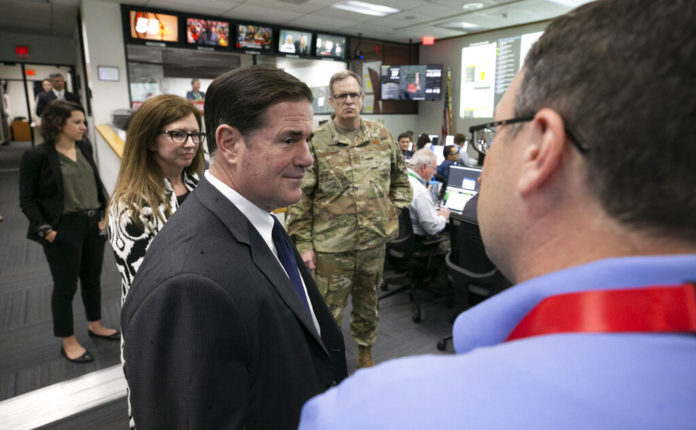
Doug Ducey on Monday imposed a stay-at-home order to slow the spread of the new coronavirus that will take effect at the close of business on Tuesday.
But he said grocery stores, pharmacies and other essential services will remain open and restaurants will continue takeout service. The order doesn’t prevent people from going to medical appointments or seeking other essential services from a long list he outlined last week. He also discouraged hoarding.
“They will remain open, and everyone should continue to buy one week’s worth of groceries for one week’s worth of needs,” he said.
The governor said he took the action after the state’s top health official said it was necessary to slow the spread of the COVID-19 disease caused by the virus.
Dr. Cara Christ, who oversees the Department of Health Services, said the rate of cases being seen in emergency rooms has been steadily rising from 2% to nearly 7% of all visits, and the percentage of positive tests had increased to about 6% of samples. She said the rise triggered her recommendation for people to stay at home.
The governor said the order takes effect at 5 p.m. Tuesday for all activity that is not essential, and he said people should still enjoy the outdoors.
“We do not want people to feel trapped or isolated in their homes,” he said. “The weather is beautiful right now. Find a way to get out and enjoy it — with physical distancing.”
Earlier Monday, the mayors of nine cities — including Phoenix and Tucson — sent a letter to Ducey imploring him to issue the stay-at-home order.
Ducey had for weeks resisted making such a call. He prohibited mayors from forcing the closure of businesses on a lengthy list of enterprises deemed essential, from hospitals and grocery stores to golf courses and parks. That order remains in effect, and businesses providing services on the list can remain open.
Phoenix Mayor Kate Gallego said on Twitter Ducey’s stay-at-home order is insufficient if he doesn’t narrow the list.
“Essential services…are not golf and beauty salons,” Gallego wrote.
People caught violating the order could be charged with a misdemeanor, but only after police warn them and provide an opportunity to comply.
Arizona had lagged most other states in imposing restrictions. Nearly 230 million people live in states where governors have issued statewide shelter-in-place orders or asked people to stay at home. In other states — including Texas, Florida and Pennsylvania — governors have resisted state-level proclamations or recommendations, but mayors and localities have acted.
State health officials said there have been more than 1,150 coronavirus cases and 20 deaths in Arizona. Greenlee County, Arizona’s smallest, reported its first case, making it subject to Ducey’s orders for bars and gyms to close and restaurants to offer only takeout service in counties with cases of COVID-19. The restrictions now apply statewide with cases reported in all 15 counties.
The existing closures have left many unable to work. Nearly 89,000 people applied for unemployment benefits last week, up from 29,000 a week before and way up from about 3,500 a week before the health crisis.
The stay-at-home order came hours after Ducey and the state’s top school official said shuttered schools would remain closed for the rest of the school year.
The extended school closure, announced by Ducey and state schools chief Kathy Hoffman, means students will have to use online or alternative learning methods to close out the year. The closure affects 1.1 million K-12 charter and traditional school students. Private schools could re-open April 30.
Before Monday’s extension, Arizona schools had been set to reopen on April 13.
Ducey said he intentionally issued a stay-at-home order rather than calling for a shelter-in-place order to reduce fear.
“When you use words like ‘shelter in place,’ that’s what happens during a nuclear attack, that’s what happens when there’s an active shooter,” Ducey said. “We want people to stay at home. It will have the same type of effect.”
The school closure announcement hit some students hard.
“They were crying this morning when they found out,” said Beth Lewis, a fifth-grade teacher in the Tempe Elementary School District who has transitioned her class to online instruction.
Schools have been working to move teaching online or send packets home to students in low-income or rural areas who lack internet connections or computers. Under emergency legislation signed by Ducey, schools are freed from classroom instruction and other requirements but required to educate students in other ways.
Hoffman’s spokesman, Richie Taylor, said some school districts are already offering online instruction while others are working to get homework packets to students. Tucson Unified School District, for instance, told Hoffman’s office only half its 43,000 students have internet access.
State corrections officials have agreed with Arizona’s 15 sheriffs not to transfer convicted inmates from county jails to state prisons for 21 days, an effort to limit spread of the disease.
For most people, the coronavirus causes mild or moderate symptoms, such as fever and cough that clear up in two to three weeks. For some, especially older adults and people with existing health problems, it can cause more severe illness, including pneumonia and death.
Republished with the permission of the Associated Press.














